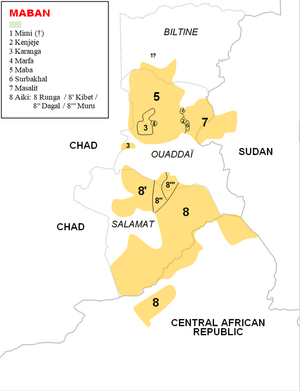Social:Maban languages
| Maban | |
|---|---|
| Geographic distribution | Chad, Sudan, Central African Republic |
| Linguistic classification | Nilo-Saharan?
|
| Subdivisions |
|
| Glottolog | maba1274[1] |
 | |
The Maban languages are a small family of languages which have been included in the proposed Nilo-Saharan family. Maban languages are spoken in eastern Chad, the Central African Republic and western Sudan (Darfur).
Languages
The Maban branch includes the following languages:
- Mimi of Nachtigal
- Kenjeje (Yaali, Faranga)
- Masalit: Surbakhal, Masalit
- Aiki (Runga and Kibet, sometimes considered separate languages)
- Mabang: Karanga, Marfa, Maba
The languages attested in two word lists labelled "Mimi", collected by Decorse (Mimi-D) and Nachtigal (Mimi-N), have also been classified as Maban, though this has been contested. Mimi-N appears to have been remotely related to Maban proper, while Mimi-D appears to have not been Maban at all, with the similarities due to language contact with locally dominant Maba.
Blench (2021) gives the following classification:[2]
- Proto-Maban
- ? Mimi of Nachtigal
- Aiki-Kibet
- Aiki (= Runga)
- Kibet
- core branch
- Kendeje
- Masalit, Surbakhal
- Maban (= Mabang)
- Karanga
- Marfa
- Maba
External relationships
Based on morphological evidence such as tripartite number marking on nominals, Roger Blench (2021) suggests that closest relatives of the Maban languages may be the Eastern Sudanic languages, especially the Taman languages, which form a branch within Northern Eastern Sudanic. Maban also shares lexical similarities with the Fur languages, Saharan languages, and even Songhay languages, but generally has more lexical matches with Eastern Sudanic languages.[2]
Comparative vocabulary
Blench (2021) posits the following consonants for proto-Maban:[2]
| (p) b | t d | tʃ | k ɡ | |
| s (z) | ʃ | (h) | ||
| m | n | ɲ | ŋ | |
| w | l r | j |
Vowels likely were ATR pairs, with at least *a *ɛ *e *i *ɔ *o *u and possibly *ɪ *ʊ, plus length.
There were likely two register tones plus the possibility of contour tones on long vowels.
Sample basic vocabulary for Maban languages:
| Language | eye | ear | nose | tooth | tongue | mouth | blood | bone | tree | water | eat | name |
|---|---|---|---|---|---|---|---|---|---|---|---|---|
| Proto-Maban[2] | *kàSì-k | *dúrmì | *sati-k; *sàdí-k / *sadi-ɲi | *delemi-k | *fàrí-ŋ | *ta-k / *ta-si | *-aɲɔ- | *mílí-ik | ||||
| Maba[3] | kàʃì-k/-ñi | koi-k | boiñ | sati-k | delmi-k | kan-a/-tu | àríi | kàñjí-k | soŋgo-k | inji | -añ- | mílí-i/-síi |
| Masalit[3] | kóo-gí/-sí | kwóyɛ̀ | dúrmì | kácìŋgi | gélmèdì | kánà | fàríŋ | kónjì | síŋgì | sá | -iny- | mirsi/-ldiŋ |
| Aiki[3] | kàs-`k/-ò | kàsá | mùndú | sàdí | àdìyím | yù-k | pày/-ó; fáai | jìŋg`r/jùŋgɔ̀rɔ̀ | rí-k | tà-k | -ñɔ̀- | mèek-í/-ú |
| Kibet[3] | kàs/-u | kàsá | mùndù | sàdí | àd`lɛ́m | yù-k | fal/-u; ari | njekedi/njùkùdú | ri-k | ta | -ñɔ̀- | m lk-i/-udɔ |
| Mimi of Nachtigal[4] | kal | kuyi | hur | ziːk | mil | ari | kadʒi | sun (< Fur?) | ||||
| Mimi of Decorse[5] | dyo | feɾ | fir | ɲain | ɲyo | su | engi | ɲyam |
Numerals
Comparison of numerals in individual languages:[6]
| Classification | Language | 1 | 2 | 3 | 4 | 5 | 6 | 7 | 8 | 9 | 10 |
|---|---|---|---|---|---|---|---|---|---|---|---|
| Maba | Maba | tɛ́ɡ, tɔ́ː | mbàːr, mbíːr, mbùl | kùŋàːl, káyáŋ | àssàːl, ássíː | tùːr, túːr | sit̀tàːl, síttíː < Arabic sitta | mɛ́ndrìː | íyyáː | ɔ̀ddɔ̀yí | ɔ̀ttúɡ |
| Masalit | Masalit (1) | tíyóŋ | mbárá | káaŋ | áás | tóór | ít̪í | màrí | àd̪á | àyi | ùt̪úk |
| Masalit | Masalit (2) | tîyom (without noun), tîle (with n.) | mbara | kaŋ | as | tur | iti | mâri | aya | adey | ûtuk |
| Masalit | Masalit (3) | tyǒm (without noun), tíiilò (with n.) | mbárá | káaŋ | ás | túr | ítí | màrí | àyá | àdɛ́i | ùtúk |
| Runga-Kibet | Kibet | doˈwai | mbaʀ | kʰasaŋˈɡal | ʔaːtal | tor | ʔiˈsal | mɪndɪrˈsɪʔ | mbaːkʰl | kʰaˈdɛijə | juˈtʊk̚ |
| Runga-Kibet | Runga | kʰanˈda | mba | kʰazaŋɡa | attɛi | tur | izɛi | mɪnˈdirsi | mbɑkadeli | kʰaddɛl | jtuk̚ |
See also
- Maban word lists (Wiktionary)
References
- ↑ Hammarström, Harald; Forkel, Robert; Haspelmath, Martin, eds (2017). "Maban". Glottolog 3.0. Jena, Germany: Max Planck Institute for the Science of Human History. http://glottolog.org/resource/languoid/id/maba1274.
- ↑ 2.0 2.1 2.2 2.3 Blench, Roger. 2021. The Maban languages and their place within Nilo-Saharan.
- ↑ 3.0 3.1 3.2 3.3 Edgar, John T. 1991. Maba-group Lexicon. (Sprache und Oralität in Afrika: Frankfurter Studien zur Afrikanistik, 13.) Berlin: Dietrich Reimer.
- ↑ Lukas, Johannes & Otto Völckers. 1938. G. Nachtigal's Aufzeichnungen über die Sprache der Mimi in Wadai. Zeitschrift für Eingeborenensprachen 29. 145‒154.
- ↑ Gaudefroy-Demombynes, Maurice. 1907. Document sur les Langues de l'Oubangui-Chari. In Actes du XVIe Congrès International des Orientalistes, Alger, 1905, Part II, 172-330. Paris: Ernest Leroux.
- ↑ Chan, Eugene (2019). "The Nilo-Saharan Language Phylum". Numeral Systems of the World's Languages. https://lingweb.eva.mpg.de/channumerals/Nilo-Saharan.htm.
- Calvain Mbernodji, Katharina Wolf. 2008. Une enquête sociolinguistique des parlers Kibet, Rounga, Daggal et Mourro du Tchad. SIL International.
Further reading
- Edgar, John T. 1991. Maba-group Lexicon. (Sprache und Oralität in Afrika: Frankfurter Studien zur Afrikanistik, 13.) Berlin: Dietrich Reimer.
- Edgar, John. 1991. First Steps Towards Proto-Maba. African Languages and Cultures 4: 113-133.
External links
- G. Starostin, 2011. On Mimi
 |
